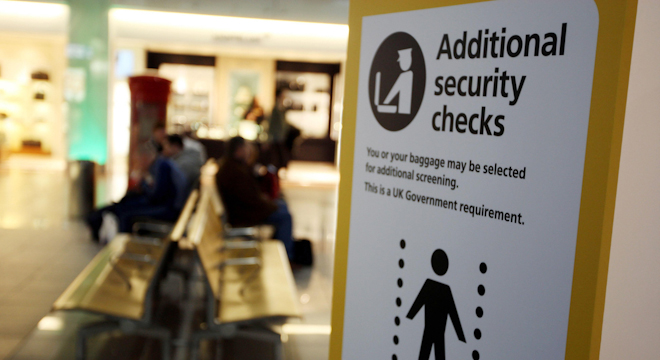It’s the latest underwear bomb plot that wasn’t.
An Al Qaeda plan to blow up a passenger jetliner running right into the hands of U.S. and U.S.-friendly officials, giving the U.S. intelligence community another victory just days after the one-year anniversary of the raid that killed Osama bin Laden.
Reports on Tuesday made clear this was not a plot disrupted, as had initially been suggested, but a remarkable infiltration of Al Qaeda in the Arabian Peninsula by a double agent thought to be working for Saudi Arabia.
Until Tuesday night, U.S. officials had only offered up very basic details. One official speaking on the condition of anonymity called the recovery of the device “a team sport” and “another example of outstanding international counterterrorism cooperation.” They said the plot was disrupted before it was even a threat to the U.S. and placed the blame on al-Qaeda.
“AQAP is the responsible group here,” the official said. “We believe AQAP produced the device, and we believe it was intended to be used by a suicide bomber on an aircraft.”
That wording was chosen very carefully — the suicide bomber, of course, was never a threat.
The official said that the device and plot “are consistent with what we know about AQAP’s plans, intentions, and capabilities” and added the that organization is likely “feeling pressure to conduct a successful attack to, from their perspective, avenge the deaths of bin Ladin and Awlaki.”
The non-metallic device is in FBI custody and officials say they expect studying it will help them adapt security practices.
“It is clear that AQAP is revamping its bomb techniques to try to avoid the causes of the failure of the 2009 device,” the official said.
DHS said that there was no specific, credible information about an attack in the U.S., according to spokesman Matt Chandler. The White House said that President Obama was told about the plot in April and received regular updates from his national security team.
There’s a wider context for the foiled plot, even if we don’t yet know many of the details of this particular incident. The case is the latest example of the Obama administration’s intensified operations against Al Qaeda in places beyond Afghanistan — an issue touched on by Ozzie Nelson, a senior fellow at the Center for Strategic and International Studies, in an interview with TPM last week.
“It was important that Obama did the one-two punch,” he said, both killing bin Laden and “expanding the operations into Yemen and other places globally.”
An article in The Los Angeles Times last month described how U.S. drones and warplanes have attacked militants in Yemen with increased frequency, following a “lull” during the time in which former President Ali Abdullah Saleh was clinging to power. U.S. Joint Special Operations Command and the CIA both fly drones over the country, and, according to the Times, the stepped-up attacks appear aimed at preventing militants from strengthening their grip on areas in the southern Yemeni provinces of Abyan, Shabwa and Bayda.
Long War Journal, which keeps an unofficial tally of the numbers, reports that the U.S. has already conducted 14 airstrikes in Yemen in 2012 — up from 10 in all of 2011.
In fact, the foiled plot this week seems to have come with its own drone strike. One government official told NBC News the strike on Sunday that killed Fahd al-Quso, a senior Al Qaeda in the Arabian Peninsula operative, was connected to the foiled plot and “part of a 1-2 blow against Al-Qaida in the Arabian Peninsula (AQAP).”
The other important aspect here is the cooperation between U.S. and Saudi Arabia.
In an interview with TPM — given before news broke of Saudi involvement — Gregory Johnsen, a former Fulbright Fellow in Yemen who now works in the Near Eastern Studies department at Princeton, said it is widely assumed that Saudi Arabia has been active running operations in Yemen over the last few years. (Writing yesterday on his blog about Yemen at Big Think, Johnsen suggested it was “likely” that the Al Qaeda double agent involved was “working for Muhammad bin Nayif in Saudi Arabia.”) He cited several instances of prominent AQAP members ending up in Saudi hands, and the execution of three men by AQAP accused of spying for the Saudis. In 2009, AQAP claimed responsibility for an assassination attempt on Saudi prince and counterintelligence chief Muhammad bin Nayif, in which an underwear bomb was used like the ones connected to both the Christmas Day attempt and this week’s failed plot.
Johnsen argued the operation is “representative” of what the U.S. and its allies are now capable of.
“One of the things that the U.S. is seen to be fairly weak on in Yemen… is human intelligence on the ground,” Johnsen said. “And that’s where this is really a great coup for the U.S. and Saudi Arabia — assuming this agent was working for Saudi Arabia — or whichever foreign partner the U.S. was working with.”
Human intelligence is important because the increase in drone strikes and air attacks has not resulted in a decrease in AQAP’s overall numbers. Instead, it’s been the opposite. In Johnsen’s view, the U.S. has not done enough to hurt the group’s “base of support” in the country.
“Why are they [AQAP] growing when the U.S. keeps attacking?” he asked. “The U.S. needs to do counterterrorism in a different way in Yemen.”
This post was updated after publication.









